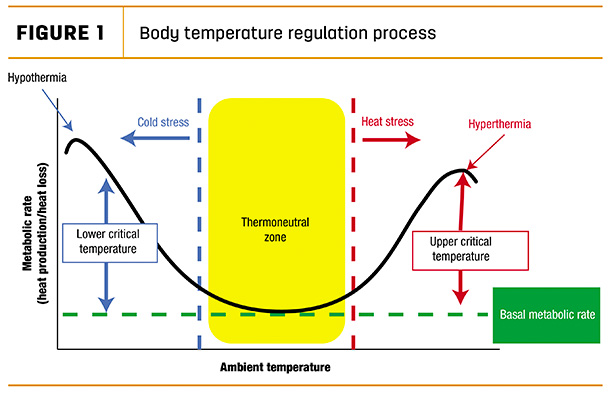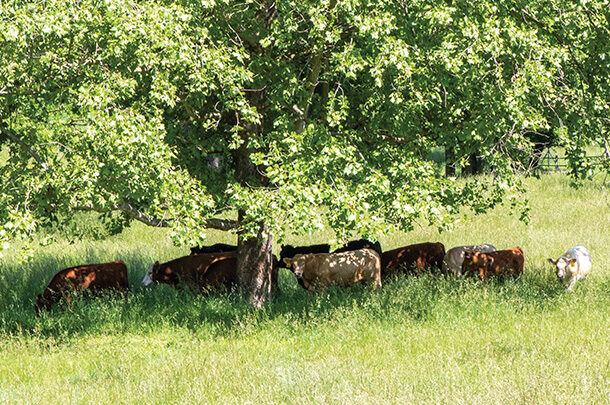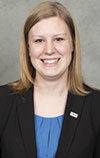As someone born and raised in the Midwest, whenever I visit ranches in the South, it continues to amaze me how cattle adapt to the environment they live in. Those, like myself, in the northern part of the U.S. often wonder how animals can handle such high temperatures over the summer months – while ranchers from the southern half are often more curious about how cattle survive the cold northern winters.
The regulation of body temperature within an acceptable range to help avoid heat or cold stress is called thermoregulation. Body temperature can be affected by hair coat thickness, body condition, wind, humidity/moisture, shelter, diet, acclimation, etc. There have also been differences in breed selection across the country to help regulate how body temperature is controlled between Bos indicus and Bos taurus breeds.
For example, transfer of metabolic heat to the skin is lower in Bos indicus cattle. Hair coat color and the amount of growth differs between breeds, and the ability to release heat from the skin through evaporative heat loss is greater for Bos indicus cattle. Each of these selection traits are vital and can provide either advantages or disadvantages for the environmental conditions cattle experience.
The thermoneutral zone
When temperatures fall within the thermoneutral zone, net energy is not necessary to produce or dissipate heat, as indicated in the yellow-shaded area in Figure 1.

The thermoneutral zone occurs when the basal metabolic rate is met. The basal metabolic rate is the amount of energy expended while at rest in neutral temperatures. On average, temperatures in this zone fall between 41ºF and 75ºF. This temperature range may vary. For cattle living in cooler northern climates who grow a heavy winter coat and those who live under primarily dry conditions, the lower temperature may decrease when factors like wind speed and shelter are considered.
When temperatures are above the thermoneutral zone, as I was experiencing in the Texas heat, they fall in the upper critical temperature (UCT) category and increase the basal metabolic rate, which stimulates heat loss to maintain body temperature. This area of UCT is what can lead to heat stress, and heat dissipation is necessary to offset heat production. The animal’s total energy requirements increase due to the body working toward dissipating heat.
On the opposite end, during periods of cold stress – such as January or February days in the Upper Midwest – cattle fall in the lower critical temperature (LCT) zone. Within this zone, the basal metabolic rate is increased under these conditions in order to produce heat to maintain or increase body temperature, which in turn increases the energy requirement of that animal. Extreme cold stress can lead to hypothermia when the ambient temperature is its lowest and the metabolic rate reaches its peak.
Turn to self-fed supplements
During periods of higher or lower critical temperatures, energy requirements increase in both scenarios in order to dissipate or maintain heat production, respectively. For fall-calving herds, this heat stress can occur at a time when energy requirements are already high, often during the last trimester. Similarly, cold stress can occur for spring-calving cows during this last one-third of gestation, or heat stress during the summer months, when we expect cows to be using additional energy to re-breed and for lactation.
Under these extreme conditions, we often drive through pastures and see cows crowded under shade trees, standing in water cooling down or, during the cold winter months, huddled together in low areas of the pasture out of the wind. Low-moisture blocks help you manage these behaviors and provide the energy required during times of heat or cold stress. Strategically placing barrels in a pasture can create a better grazing distribution.
Furthermore, increased forage utilization to get more out of your grass may result even during periods of extreme heat, when energy requirements may be at their peak. During colder periods, cattle often minimize their movement and may seek more protection from the elements. In this situation, place barrels where cattle will easily access them, out of wind-exposed areas.
In addition to being convenient for your cows to visit when needed, supplementing with a self-fed supplement is also convenient for you. During the high heat of the summer or cold winter days, one of the last things you may want to do is spend more time than necessary outdoors. Minimize your time and efforts by providing controlled and consistent intake with self-fed supplements – during these periods especially but also year-round – to maintain optimal cattle health. Doing so can prove to be very valuable in meeting the nutritional demands of your cows.








